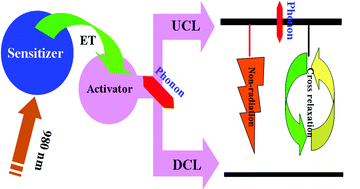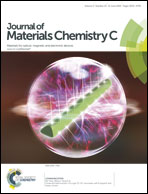Phonon-modulated upconversion luminescence properties in some Er3+ and Yb3+ co-activated oxides†
Abstract
The competition between 4I13/2–4I15/2 near-infrared downconversion emissions and visible upconversion emissions of 2H11/2/4S3/2/4F9/2–4I15/2 is a vital factor for obtaining efficient upconversion luminescence (UCL) in Er3+ and Yb3+ co-activated oxides. In this paper, we systemically studied the entire emission spectra of Er3+ ranging from 400–1700 nm in Er3+ and Yb3+ co-activated cubic Y2O3, tetragonal GdVO4 and tetragonal NaGd(WO4)2 micro-sized powders, prepared by the same sol–gel method, which have different phonon thresholds, 600 cm−1, 880 cm−1 and 1000 cm−1, respectively. It is interesting to observe that in these phosphors, the visible UCL of Er3+ relative to near-infrared emissions increase remarkably with the increase of phonon thresholds. In comparison with the UCL in the Y2O3 host, the UCL in YVO4 and tetragonal NaGd(WO4)2 was tremendously improved by 9.5- and 120-fold, respectively. The UCL intensity of the NaGd(WO4)2:Yb3+/Er3+ was comparable to that of the famous UCP NaYF4:Yb3+/Er3+. A model was proposed to explain the phonon-modulated UC process. This work is of great significance in the search for a novel, efficient UCP.


 Please wait while we load your content...
Please wait while we load your content...